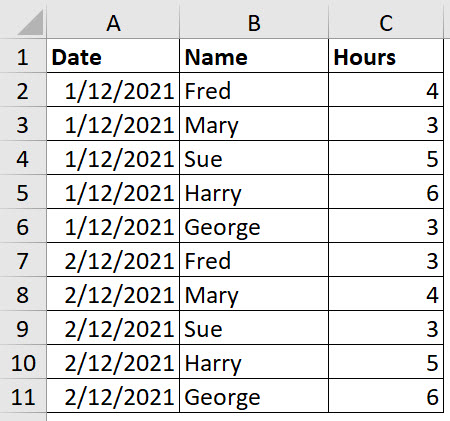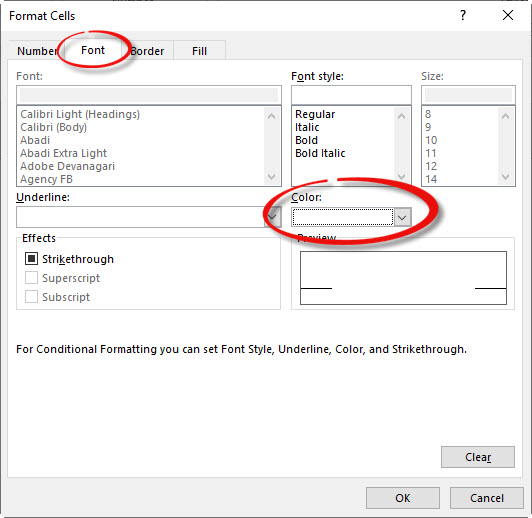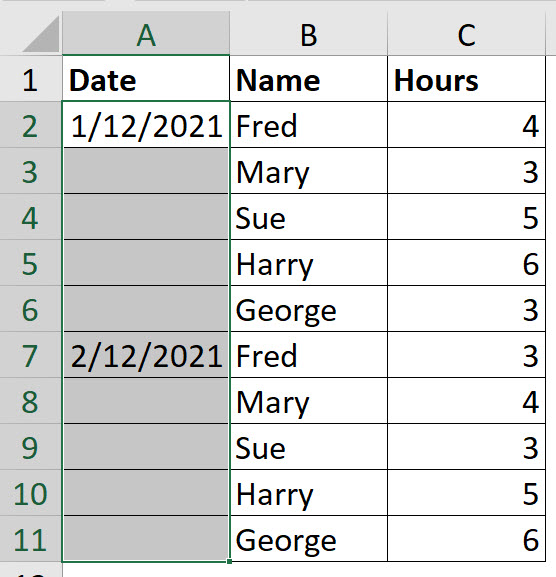Thanks to Rick Rothstein MVP for sharing a LinkedIn article he wrote a while back about colour constants. He gave me permission to share the contents in this post. Making your own colour constants.
Tag Archives: formatting
Outside Borders in Excel
How to apply to a range
I use the thin all borders format a lot. But there are times when I need to use the thin outline (outside) borders. This border is not as straight forward to apply to a range.
Clearing All Formats in Excel
Sometimes with Excel formatting you just want to clear everything and start again from scratch. You can clear just the formats, and there is an icon you can add to the Quick Access Toolbar to make clearing all the formats earlier.
Formats Affect Excel’s Fill Handle
Applying a date format before you drag with the Fill Handle may save you some time. See why.
Date Alignment Trick in Excel
Text alignment in Excel is versatile. If the column isn’t wide enough to display the text, it will display over the next cell. Date and number alignments are not so forgiving. If the column isn’t wide enough the cell with display the ### symbols or the scientific format. Here is a function technique to get around the limitation.
Formatting Input Cells in Excel
Formatting input cells consistently is best practice
It is common to have a lot of input cells in an Excel file. It is best practice to use the same format for all the input cells. This makes it easier to identify input cells for you and the user. Here is a technique using Conditional Formats that may be useful.
Conditional Format to Display Only the First Entry
In my previous blog post I showed a technique to reduce clutter. The technique used a manual formatting method. Here is the automated version.
You can see my previous post here.
Below is the original table.
We can use a Conditional Format to only display the first entry of each date in the Date column.
Select the range A2:A11.
Click the Conditional Formatting drop down and select New Rule (third from the bottom).
Select the last option in the top section “Use a formula to …”.
In the formula box enter the following formula.
=COUNTIF($A$2:A2,A2)>1
Click the Format button and use the Font tab and change the font colour to White and click OK and then OK again.
The result is shown below.
The formula for a conditional format must return TRUE to trigger the format. The type of formula that you use is called a logical test, which returns either TRUE or FALSE.
The use of the $ signs is very important in this formula. The COUNTIF function counts the number of entries in a range. If the COUNTIF result is above 1 it is a duplicate. In cell A2 the formula will ALWAYS return 1 as it is counting itself.
When creating a formula-based condition across a range you need to build the formula to refer to the top left cell of the range. In this case we need the range to expand as the range extends down the sheet. Hence, we didn’t use any $ signs on the last two A2 references used.
In cell A3 the formula will be.
=COUNTIF($A$2:A3,A3)>1
This is because the A2 references in the original formula had no $ signs, so they will change with the cell to A3. In our case this COUNTIF will return 2 because the date in cell A3 is a duplicate of the date in A2. This will trigger the format.
This formula expands as the range extends. It uses the cell reference of the cell it is in to determine if the entry is the first entry or a duplicate. This formula will not change the format of the first entry, but it will change the formats of any duplicates.
Input Data Display Hack for Excel
Getting the format white
When creating data input sheets, it is a good idea to use a table layout. Sometimes they can end up looking a little bit busy, especially if you are repeating entries down rows. To help users focus on what they need to do, you can use a little formatting hack to make the layout look a little less cluttered.
Excel Macros and Merged Cells
Merged cells are a problem
I don’t like merged cells. Here is one more reason.
Putting Excel into Lock Down
Locking involves a format
There are a few lock downs in place around Australia at the moment, so let’s look at putting Excel into lock down.
Make Sure All Input Cells Have an Entry in Excel
COUNTIF to the rescue
When creating an input range you may need to validate input cells. That may mean ensuring all input cells have an entry. Here’s how.
One Minute to Excel #12 – Hide Cell Entries
It is a special format
You can’t hide a cell, but you can stop the cell value from displaying on the sheet.
It involves a custom number format.
Prefix Numbers Conditionally in Excel
Conditional Format to the rescue
Let’s say we need to put a prefix in front of a number to identify the period being used. Whether that be year, month or week.
Single Accounting Underline
Great for headings
I learned something new recently about underlines. They are not all created equal. The Single Accounting underline has some advantages.
Text for a week in Excel
Time to TEXT
When working with weeks in Excel you may need to show the start and end date of the week in the same cell. Here’s how you can do that.
Percentage Area Chart in Excel
Conditional Format technique
You can use a pie chart to display a percentage, but it wastes a lot of space. An alternative that takes up less space is an area chart.
Excel Border Icons
Speed up your work
I typically turn gridlines off on my sheets and then use borders for the lines. I have added icons to my Quick Access Toolbar to speed up the process.
Data Validation and Conditional Formats in Excel
Part Two - a good combination
In my previous post I showed how to have a flexible data validation and how to validate it. This post will look at adding conditional formats to inputs and validations.
Excel Sort within a Sort
Colour by numbers
Did you know you can sort by colour in Excel? Did you know you can sort ascending or descending within that colour? I was asked a question in a recent webinar and in answering I found out that you can sort within a sort.
Applying a standard custom format in Excel
Styles to the rescue
One of the most common custom number formats used in Excel is the mmm-yy format. As an example this format displays all the dates in January 2019 as Jan-19. This format is used in most reports, budgets and financial models. There is quicker way to apply it than using the Format Cells dialog.
Putting Emphasis on Words in Excel
Don't overdo the colours
Did you know that you can format individual words and letters differently within an Excel cell or text box?
Free Webinar Recording – Excel Formatting Tips
Feedback score 94% based on 70 responses
In October 2019 I re-ran my Formatting Tips session. The detailed pdf manual and example file can downloaded by using the button below. Content listed below the video.
CPD note – if you are claiming CPD for watching this recording you need to keep your own records. People who attend the live sessions receive an annual listing of attendances.
This session covers:
- a format to avoid and the one to use in its place
- keyboard and mouse shortcuts
- how to use and create customer number formats
- about Styles and how they can make your formatting more consistent
- that colours can be used to filter, sort and even find things in your sheets
- how to stop zeroes displaying plus other general formatting tips
- a quick demo of Flash Fill
Automate Strike Through Format in Excel
Task done!
Who doesn’t get satisfaction from drawing a line through a completed task? That sense of achievement. Well you can do the same in Excel.
Unlocking coloured cells in Excel
Styles and Find solutions
When you create an Excel file that handles inputs it is best practice to colour code the input cells. The colour you choose isn’t important but making sure you use it consistently is. You may need to unlock the input cells if you plan to add sheet protection to the file. Here’s a couple of ways to do that.
Restricting column inputs based on the current month
A data validation solution
Let’s say you have an input range that covers the whole year. You only want users to make entries in the current month column. How can you limit the month entry? The answer is a custom Data Validation.
Free Excel Webinar Recording – Custom Number Formats
Feedback score 92%
In April 2019 I demonstrated many of Excel’s Custom Number Formats.
CPD note – if you are claiming CPD for watching this recording you need to keep your own records. People who attend the live sessions receive an annual listing of attendances.
In this brand new webinar we examine Custom Number Formats which hide away at the bottom of the Number Format tab. These custom made formats offer some useful techniques.
They can
- display negatives in red and with brackets
- format mobile phone numbers correctly
- display numbers and text together and still perform calculations
- hide zeroes
- display rounded numbers to thousands and millions
- display the day of the week
- create customised dates
- be saved and be available in new sheets and files using a Template
- be saved as a Style
See examples and demonstrations of many different custom number formats and learn how to create your own.
As always I will share a few other tips.
Automate Input Cell Colour
Use a CELL function option
It is best practice in Excel to have a consistent colour for input cells so that users know where they can and need to make changes. You can automate this process by using a Conditional Format.
Autofit columns with a limit
A macro to the rescue
The column Autofit on the whole sheet is a great Excel feature. But if you have a few columns that have lots of text it can make using it problematic as you need to manually adjust those wide columns. Here’s a macro to make it easier.
Unique Entries in Excel via a Conditional Format
Filtering to the rescue
Excel’s Conditional Formatting feature has a built-in unique option. Its unique option only identifies entries that are not repeated. This is different to the Advanced Filter Unique option which lists each unique item from a range once. To filter by entries only appearing once you can use Conditional Formatting with filtering. No formulas required.
Controlling a Conditional Format with a Checkbox
Turn it off and on
Here is a technique that allows you to turn off and turn on the conditional format without actually removing the conditional format. You may want to do this to print a sheet without the conditional formats being applied.



